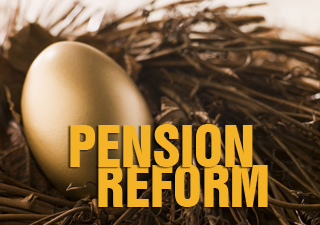Media
Pension Crisis Deniers Debunked
 Last Thursday night, Katrina Currie debated the AFL-CIO’s Rick Bloomingdale on PCN’s call in show on the public pension crisis. Bloomingdale largely argued that there was no crisis (at least not one that couldn’t be solved with higher taxes).
Last Thursday night, Katrina Currie debated the AFL-CIO’s Rick Bloomingdale on PCN’s call in show on the public pension crisis. Bloomingdale largely argued that there was no crisis (at least not one that couldn’t be solved with higher taxes).
Here are just five inaccuracies Bloomingdale put out:
- $48 billion “isn’t much.” When Katrina outlined the scope of the problem—a $48 billion unfunded liability between the two state plans and municipal pension plans—Bloomingdale blew off this massive amount, claiming we have decades to pay off this debt. This is misleading for two reasons. First, this means taxpayers will still be paying for current workers pensions long after they are retired. This is like setting up your own IRA to use when you turn 65, but planning to pay into it until you are 80.
Second, the $48 billion represents what taxpayers need to put into the plan today, invest it and have the investment grow by 7.5 percent each year to have enough funds to make pension payouts. By spreading this cost out over decades, taxpayers pay more. Based on numbers from the State Employees’ Retirement System (SERS) and the Public School Employees’ Retirement System (PSERS), taxpayer pension costs over the next 17 years will be approximately $115 billion.
- Pensions won’t drive up property taxes. Despite these astronomical figures, Bloomingdale asserted that any increase in property taxes won’t be because of pensions. Yet 200 school districts received pension exemptions to raise property taxes above the Act 1 Index last year alone.
And that is before the real pension bomb hits. Within 5 years, annual pension costs will be more than $1,000 more per household than today. Another recent study, based on a lower assumed rate of investment returns, says Pennsylvania taxpayers need to put in $1,550 more per household each year for 30 years to pay off our pension deficit.
- The “state share” of education spending is too low. On the topic of property taxes, Bloomingdale blamed state government for not spending enough, saying, “The Constitution requires the state to contribute 50 percent of school spending.” Well, that isn’t in the Pennsylvania Constitution. Moreover, the state share has never been 50 percent of education revenue.
- The taxpayer cost of pensions is only 3 percent of employee’s salary. Bloomingdale claims that Act 120 of 2010 lowers the cost of pensions to 3 percent of salary. This was based on an analysis of that bill when it was being debated, and only applies to new employees hired in 2011 or after (a fact Bloomingdale skipped), and is the remaining estimated “normal cost” after employees put in 7.5 percent of pay.
That projection is also based on achieving an 8 percent return on pension investments each year. Both SERS and PSERS have lowered their projections since then, adding billions more to pension deficits. Most importantly, the pension bomb is largely the result of failing to achieve these rosy rates of return. Because of that, the real cost to taxpayers is projected to rise to around 30 percent of state and school district payroll.
- State government didn’t make its contribution. This is a half-truth often circulated by government union bosses to shift blame. There were three pieces of legislation that allowed the state and school districts to reduce their pension contributions over what would otherwise be required. Act 9 of 2001 reduced payments into pension plans due a surplus—union bosses lobbied for this law, as it also increased pension benefits (adding $10 billion to the pension liability). Act 40 of 2003, delayed pension payments following stock market losses—and union bosses supported this bill too, as it allowed state government and schools to spend freely elsewhere. And Act 120 of 2010 kicked the can down the road again—with union boss support, as they recognized the pension spike was unaffordable. The big problem: What was unaffordable in 2003 and 2010 won’t be any more affordable in 2015.
Union bosses need to stop denying a pension crisis and realize the need for real reform. The first step is to move all new employees to a 401(K)-style plan, which would prevent the political shenanigans Mr. Bloomingdale has exploited.